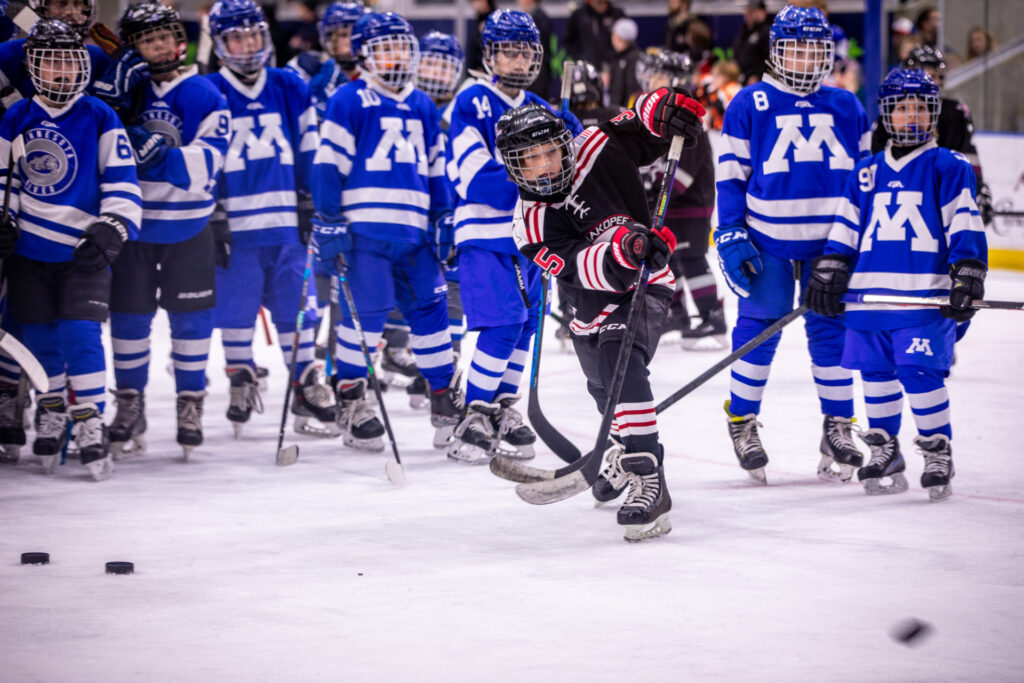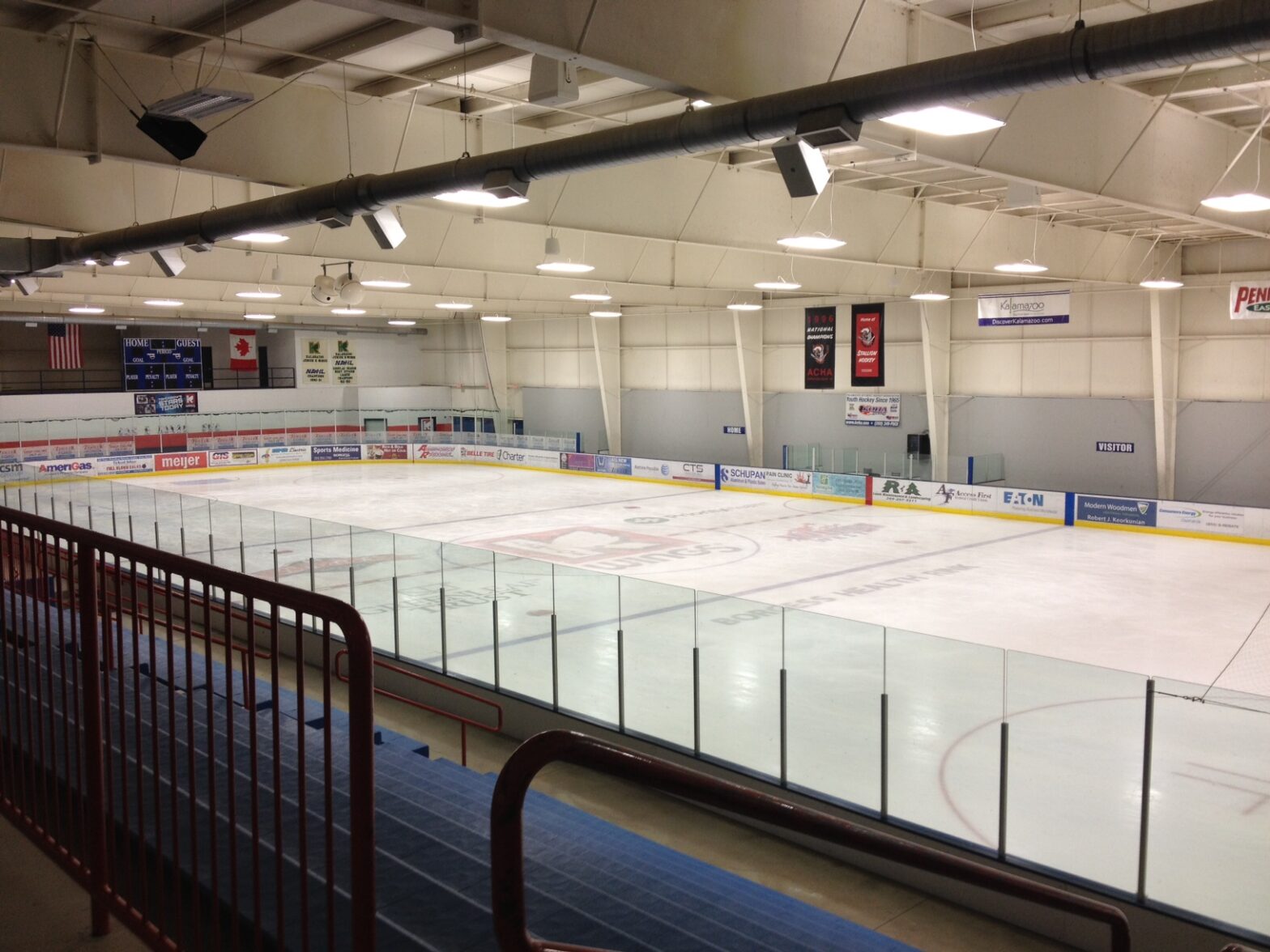
Hockey thrives in the Midwest, where the cold weather is naturally conducive to the sport. Communities invest in state-of-the-art facilities and warm hospitality to attract hockey tournaments. Exceptional rinks and citywide hospitality keep cities competitive while vying to bring tournaments to their region.
Top-notch facilities
The popularity of professional hockey in the U.S. and increased accessibility to the game continue to fuel the growth of youth hockey. During the 2023-24 school year, there were more than 42,000 high school ice hockey players in the United States—an increase of 405 participants from the previous year, according to
USA Hockey.
Savvy communities that host hockey tournaments are building or expanding their facilities to accommodate all players, families, fans, and coaches.
“Having [multiple] sheets of ice is what’s going to entice people so you can showcase many more teams,” says Domico Rodriguez, executive director at Rapid City Sports Commission in Rapid City, S.D.
Rodriguez says building cooperative relationships with city leaders and other sports organizations to ensure enough ice time for hockey and other ice sports is a significant factor in successfully hosting hockey tournaments.
Blaine, Minn., outside Minneapolis, is home to Super Rink, the world’s largest amateur sports facility that serves eight communities. Year-round, Super Rink hosts more than 100 events and tournaments for youth and adult hockey, figure skating, broom ball, short track speed skating, and sled hockey.
Super Rink is an eight-sheet ice arena on the National Sports Center campus. It’s a combined project of 11 local governmental partners, the Minnesota Amateur Sports Commission, and various youth hockey associations.

Super Rink is home to the U.S. Women’s Olympic Hockey Team, and the popularity of girls’ hockey has fueled the demand for sheets of ice.
According to USA Hockey, participation in girls’ hockey has increased 65 percent over the past 15 seasons. The U.S. Women’s Olympic Team’s winning gold medals in 2018 and 1998 have fueled interest in the sport, and Title IX increased accessibility
to hockey. Title IX gives women athletes the right to equal opportunity in sports
at educational institutions that receive federal funds.
“We had four rinks in 1998, then we added four more, all because of Title IX,” says Pete Carlson, senior director of operations and programming for Super Rink. “The girls were not getting the same ice opportunities as the boys…[but now] we’ve got huge girls’ tournaments here. That’s a big part of our existence.”
More ice means more opportunities to host boys’ and girls’ teams nationwide. Youth hockey leagues from multiple states hold their end-of-season tournament at Super Rink, which brings teams, families, scouts, sponsors, and vendors to a single location.
“If an association has eight teams that all want to practice at the same time, they can do that here. That’s unique to us,” says Carlson.
Carlson adds Tier III brings its entire league and takes over Super Rink for three or four days for its playoffs.
“Everybody gets to watch at least a little bit of [the games] instead of being thousands of miles apart from each other with their events,” he says. “We can do that with eight teams or 80 teams.”
Fargo, N.D., opened a new sports facility, Fargo Parks Sports Center, in January 2024. Fargo has 19 sheets of ice within 10 to 12 minutes of each other to accommodate multiple hockey tournaments happening there most weekends.
Fargo is across the Red River from Moorhead, Minn., and 160 miles from the Canadian border. The Fargo-Moorhead region has three hockey associations and hosts more than 20 tournaments just for youth hockey associations.
“Our largest events are youth hockey,” says to Stephonie Broughton, director of sports for Visit Fargo-Moorhead. “The percentage of traveling teams is quite high. We get teams from all over the United States…we’re close to Canada, too, so that’s attractive. They can drive down and play.”
Beyond adding ice sheets, sports facilities offer workspace, meeting space, and experiences appealing to teams and their families.
“You used to go to the ice rink and it used to be a metal building with bleachers and locker rooms, and you dropped your kid off,” says Carlson.
“Now it seems like the hockey is a little bit secondary in how rinks are being built. Now, it’s everything above and beyond. Do you have Wi-Fi? Do you have a place to sit where it’s warm and TVs? Do you have a concession stand, and what does it sell?” he explains. “Super Rink has done a really good job of having those kinds of amenities inside the ice rink.”
With about half the school year tournaments starting on Fridays, Super Rink provides space for parents who need to work on-site.
“Employers understand their employees can work from home [or anywhere]. Super Rink has places where you can sit in a quiet corner, watch a game, and have your computer, phone, and Wi-Fi,” Carlson says. “Having amenities for parents and people watching is now the thing to do.”
Broughton says technology needs to keep pace with the demands of parents and fans who, for example, shoot videos of games, stream them, or send videos and photos to grandparents.
“When you have that many bodies in
a facility, your technology can be gobbled up if they’re streaming the game,”
she explains.
Fargo Parks Sports Center offers rentable spaces, so teams using the facility can have places to gather, have meals together, or watch movies between games. Each room includes a big-screen TV and Bluetooth. Officials can be treated to a private, unmarked lounge during their downtime.
“It’s so cool. They’re away from everything,” Broughton says. “It’s really quiet. They have a wet bar stocked with water and snacks for them and a seating area with comfy chairs and TV and workstations. There’s an opportunity
to decompress.”
Concessions at places like Super Rink and Fargo have moved beyond hot dogs, popcorn, and candy. Fargo Park Sports Center, for example, has a full commercial kitchen that serves homestyle fare like macaroni and cheese and can provide vegan or other special dietary options.
The on-ice atmosphere is also becoming more sophisticated. Carlson says Super Rink plans to renovate some of its rinks to provide players with an atmosphere mimicking professional hockey.
“We have a nice sound system. We want to drop lights, put on some spotlights, and have the red light and siren going as [each] team comes on the ice. Those amenities you can put into an ice rink make it special. You need music, you need an announcer, and now we need to drop the lights like the National Hockey League does…to get these kids to feel like they are the most important person for an hour and 15 minutes,” Carlton says.
Community partnerships
All the cutting-edge amenities must be paired with hospitality and consistent customer service, so teams want to return.
“If we are not saying ‘hello,’ ‘good-bye,’ and ‘how are you’ as a staff, [teams, fans, and families] aren’t coming back,” Carlson explains. “They need that customer service. Super Rink does a good job with cleanliness, hospitality, and our concession stand. Those little things don’t cost a lot, but if they’re not here, people will not come back.”
Cooperative partnerships between local businesses and attractions contribute to giving hockey teams positive experiences when they travel for a tournament. Reasonably priced motels and hotels are essential, Rodriguez says, especially during winter months that are typically off-season for tourism.
Visit Fargo-Moorhead promotes sports and events through their social media and sends alerts to the region’s businesses about events that will bring an influx of visitors. This gives restaurants, gas stations, hotels, and attractions time to ensure they have adequate staffing and are prepared for bigger crowds.
“We implemented some additional communication things with facilities and restaurants and malls and attractions for pretty much any event where we’re expecting 2,000 participants and spectators or above,” says Broughton.
Thriving home teams also contribute to a city’s appeal as a tournament host community. Rapid City is home to pro hockey team The Rush. Rodriguez says the Rush’s fan following has helped develop local youth hockey for kids from age five through college. The region’s Tier III team gives high school and college hockey players opportunities to get noticed by more prominent universities.
“The biggest component for recruiting outside events is you need to have a strong local [hockey] organization because most tournament directors need a large pocket of teams that can be from the local area or the region to fill those spots early,” he explains. “The good competition in those events will attract people from further away.”









